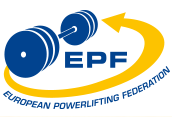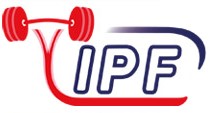History of EPF 1977 – 2020
Author: Arnulf Wahlstrøm, 2021-01-01
Early history of powerlifting
Powerlifting, as we know it today, was practised in several countries in the late 60’s. The inspiration and inputs came from such famous strength athletes as Doug Hepburn (Canada) and Paul Anderson (USA) who lifted heavy weights in both squat and deadlift in the 50’s and 60’s.
In USA the first Nationals in powerlifting was organized in 1964, in Great Britain in 1966 and in Norway in 1968.
Probably the first international competition in powerlifting was staged between Great Britain and France. In 1968 a team of six French lifters were invited to Bristol and the year after a team of six British lifters went to Paris for a return match. In these competitions no dead lift was included and in squat the lifter had to stay down in the squat until the referee gave him the signal to return up again. The British team won the competitions.
In 1970 a team from Great Britain was invited to USA for an “unofficial world championships” by “the great American benefactor of the strength sport”, Bob Hoffman.
The following year Bob Hoffman invited again for an unofficial World championships in York, Pennsylvania in USA. Only lifters from Great Britain and USA took part.
Bob Hoffman repeated his invitation in 1972 and after the event, a meeting attended by delegates from the participating nations was held on 11 November in Zembo Mosque, Harrisburg, Pennsylvania and the International Powerlifting Federation (IPF) was founded.
The first official World Championships were held in November the following year 1973.
Foundation of EPF

European Powerlifting Federation was founded 14 May 1977 in Turku, Finland. The following delegates took part: Vic Mercer (GB), George Leggett (GB), John Moody (GB), Arnold Boström (SWE), Georg Boström (SWE), Jaakko Parviainen (FIN), Bror Holm (FIN), Emil Emilsen (NOR) and Helge Stave (NOR).
Jaakko Parvianen was elected President, Wally Holland (GB) Secretary and the following four Vice Presidents: Vic Mercer, Bror Holm, Georg Boström and Emil Emilsen.
During the first 10 years of its history, EPF had no separate Constitution or By Laws and much of the administration was done in co-operation with the IPF Executive. For most of those 10 years Vic Mercer (GB) was the President in both federations and Arnold Boström (SWE) the General Secretary and Treasurer in both.
The first European championships were organized in Birmingham in 1978. 63 lifters from 11 nations took part. Taito Haara from Finland became the champion of champions. He lifted 400-225-355=980 kg in +110 kg category (140,0 kg body weight). This was an impressive result at a time when the supportive gear had not yet been developed.
Great Britain won the team award ahead of Finland and Sweden.
Constitution and By-Laws
At the EPF Congress in 1987 an EPF Constitution and By-Laws, prepared by Vic Mercer, Heiner Köberich and John Moody, was accepted by the Congress.
This was a mile-stone in the history of EPF and from that year, the EPF had the authority to build European powerlifting into a strong and efficient sport.
Categories of European Championships
Open Men.
From 1978 the Open European Championships for Men were held annually and in 2006 the first combined championships were held for both Men and Women.
Open Women.
In 1983 Heiner Köberich took the initiative and organized the first Open European championships for Women in his home city Darmstadt in Germany. 52 lifters took part from 11 nations.
Tina Woodley, from the Netherlands, won the champion of champions award lifting 150 – 87,5 – 180 = 417,5 kg in the 56 kg class.
Juniors.
The first European Junior Championships for Men were organized in Soest, Germany in 1985.
80 lifters from 15 different nations took part and the champion of champions was Jarmo Virtanen from Finland lifting 300 -197,5 - 317,5 = 815 kg in the 82,5 kg class.
The European Junior Championships for Women were introduced in 1995 and organized in Cherkasy, Ukraine. 34 lifters competed from 9 countries and champion of champions was Oksana Belova from Russia with 165 – 90 – 178 = 432,5 kg in the 52 kg category.
The first European Championships for Junior Women took place together with the Junior Men but was run on separate competition days.
Masters.
European Masters Championship for Men were introduced in 1988 and organized by Great Britain in Milton Keynes. The age categories were “over 40” (Master I) with 59 athletes and “over 50” (Master II) with 49 athletes. 11 nations were represented.
Champion of champions were Bill West (GB) in Master I lifting 320 – 175 – 320,5 = 815 kg in category 90 kg and Herman Blank (GER) in Master II lifting 335 – 190 – 310 = 835 kg in the 125 kg category.
In 2001 a Master III category (over 60) was introduced and from 2006 lifters above 70 years competed for the best lifters awards (gold, silver and bronze) according to Wilks point.
In 1995 the first European Master championships for Women took place in Valencia, Spain.
The weight grouping was -52 kg, -67,5 kg and +67,5 kg and 16 lifters from 7 nations took part.
Tony Hollis from Great Britain was the best lifter with 155,5 – 87,5 – 150 = 392,5 kg weighing 56,0 kg.
In 1999 the age grouping for Master I Women was following the ordinary weight categories and in the same year a Master II category was introduced. From 2006, lifters above 60 years competed for the best lifters awards according to Wilks points.
Commencing in 1995 the European Women Master Championships were combined with the Master Men’s in one championship.
Bench Press.
Open European Bench Press Championships for Women and Men started in 1995 and for Masters in 1998.
Classic lifting.
European Classic Powerlifting championships started in 2015 with the Open, Junior and Sub-junior categories in Pilsen in Czech Rep.
European Classic Bench Press championships started in 2017 with all age categories in Ylitornio in Finland
In 2018, the European Masters Classic Powerlifting was organized for the first time in Hälsingborg in Sweden.
Congress

The EPF Congress takes place every year on the day before the Open European Championships.
Delegates from each member nation and EPF officials are invited. Each member federation and each EPF Executive member have one vote and the By Laws proposals and election of officials are democratically decided by a majority vote. Constitutional proposals need 2/3 majority.
Election of EPF officials takes place at the Congress every 4 years.
Presidents and Vice Presidents
Up to 1986 one EPF vice president from each member nation was appointed at the annual Congress. These vice presidents had no “executive mandates” and were not appointed to take care of any particular duties within the EPF. They were contact persons for EPF related matters in their national federations.
This changed in 1987 with the implementation of the EPF Constitution. As from 1988 only one EPF Vice President is elected every 4 years and serves as a member of the EPF Executive board.
Since the foundation of EPF in 1977, 5 presidents have been in charge and two of them died during their presidency. Helge Stave from Norway acted as president only one and a half year before he died in 1981 and Wouter v.d. Toorn from the Netherlands was president for two years before he died in 1989.
Eastern Europe
A new dimension in European and Worldwide powerlifting was introduced when the former Soviet Union countries and other Eastern European countries joined the EPF and IPF starting at the end of the 1980’s.
However, the process to “open up” or co-operate with Eastern Europe by the EPF and IPF started in 1983. Czechoslovakia invited that year lifters from Norway, Belgium and West Germany to take part in an international competition in Most. 3 lifters from Norway, 5 lifters from Belgium and 4 lifters from West Germany took part besides lifters from Poland, East Germany and Czechoslovakia.
After this competition, contacts were established and next year, lifters from Czechoslovakia took part in the Open European Championships in Norway. Poland invited Norway and Czechoslovakia to take part in the open National championships in Zory in December 1984. In 1987 the Baltic Cup was established and hosted for the first time by Poland in Gdansk.
The Soviet Union became a member of the EPF and IPF in 1990 and was in 1992 replaced by Russian membership.
Members and championships

The EPF was formed by 4 nations in 1977. In 2010 the EPF has grown to 30 full member nations and about 5 tentative or provisional members.
About 700 lifters competed in European championships in powerlifting and bench press.
In 2020, there are 35 full member nations.
8 categories of European championships are organized annually with about 2200 participants in total. In addition, the Danube Cup is organized biannually.
The EPF is by far the strongest region within the IPF as regard to medal winners in World championships and also with regard to number of member nations.











